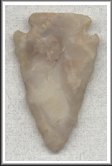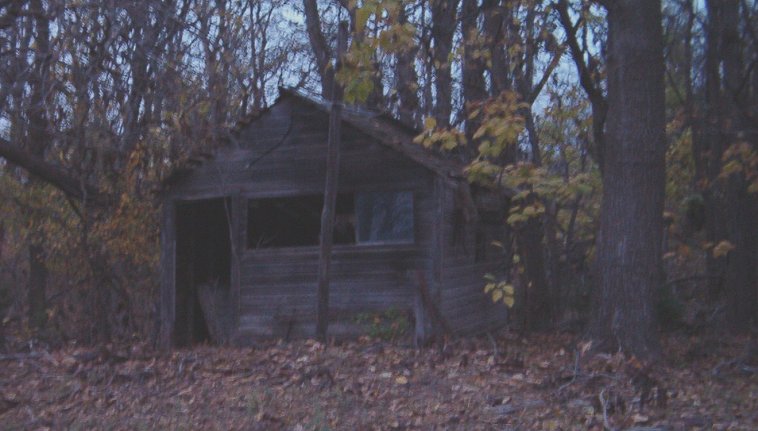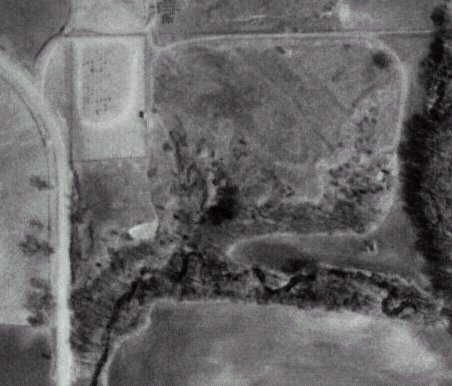In this interview, numerous references are made to a "dinosaur bone" found by Ernest Ferrin. It was actually a mastadon bone. Somewhere I have a copy of his original letter to Kansas State University which accompanied the bone when he sent it to them, as well as a copy of their reply. Both are still on file at the university and copies were sent to me when I requested them. -- J.F. Interview with Wendel Gene Ferrin of Tucson, Arizona,
by Jerry Ferrin, 13 April 1989
<====================<<< >>>====================> Jerry: Dad, I just received a letter today from Evelyn Reed, the librarian at Coldwater, Kansas, telling me that Randall Thies, the Kansas State Archaeologist, will be digging for Indian artifacts this June on the land we call the Zoo on the north edge of Wilmore, Kansas. Evelyn has some questions about the arrowheads that you and Poppy (Ernest Leroy Ferrin of Wilmore) found on The Zoo and about the Indian skull that Poppy found just south of his shop on his home place. How big would you say the collection of arrowheads was that Poppy had?
Wendel: I don't remember the number, but I know that they all fit in a cigarbox.
Jerry: And that was about 5" deep by 8" wide by 12" long?
Wendel: No, I don't think it was a tall cigar box. It was lower, about 2" tall.
Jerry: Oh, I would have sworn it was about 5" tall.
Wendel: Well, I could be mistaken, Jerry. I just don't remember. To my recollection, I'd say there probably weren't over twenty in there.
Jerry: I'd guess that there were about 50 arrowheads, because I remember the cigarbox as being about half full and that the box was about 5" tall. What kind of specific items do you recall?
Wendel: Arrowheads, some lead bullets. I remember one iron arrowhead in particular and there was one tomahawk head. It was a small tomahawk, probably four inches long and, at the wide point, probably not more and an inch and a half, then it came down to a point on the other end. It was triangular shaped. From my idea of what a tomahawk is, and I've seen them in other collections, it was a small one but it was definitely a tomahawk head.
Jerry: I remember that there were some (arrowhead) points which were real small. He had one perfect (undamaged) one which was probably about 3/4" long.
Wendel: That's right.

At left: An arrowhead found by Ernest L. Ferrin at 'The Zoo', actual size: 1 & 1/2 inches by 7/8 inches, collection of Jerry Ferrin.Jerry: And I've got one which Grandma Nellie (Nellie May Barnett Ferrin) gave me after Poppy died. It's a perfect one that's about an inch and a half long. But quite a few of the arrowhead's in Pop's collection were broken.
Wendel: Most of them were broken, to my recollection. Sometimes both parts were there, but an awful lot of them were broken.
Jerry: One of them I remember had the tip broken off, but the base part which was left was about 5" long.
Wendel: That's true. It could have been a spearhead. I recall that one too and I always thought it was a spearhead.
Jerry: And those lead slugs... what caliber of gun would you estimate that they were from?
Wendel: (Laughs) Probably a .45 - I'm not good at estimating calibers but those slugs were a large caliber.
Jerry: So they were probably 3/8" in diameter at the base?
Wendel: No, I think they were even larger than that: seven sixteenths or possibly even one half inch - they were large slugs. I found one up on the North Place (wheat land Wendel leased in Kiowa County which belonged to Bonnie Hibbert) which had the tip bent over that was about 7/16" diameter and about 3/4" long.
Jerry: That sounds about right to me for the original size of the spent slugs in Pop's collection. I recall them, about six of them, as being flattened on the pointed end and compressed back towards the base as if they'd been fired into something. Those spent slugs were, I guess, about 1/2" long. Evelyn asked in her letter if there's anyone around Wilmore that Poppy may have shown the collection to whom Evelyn could contact now.
Wendel: Buck (Delmer Lee Ferrin) might know. He might have them. I don't have the slightest idea of where they are. I'm pretty sure he never gave them to an institution. I didn't know it if he did. Buck might have the collection or might know what happened to it. Other than him, I don't know of anyone who would know anything about them.
Jerry: I remember seeing Poppy's arrowheads on display - or seeing some arrowheads on display and hearing at the same time that he loaned his arrowheads to some institution for study and display. Evelyn Reed told me that there did used to be a museum at the State Fish and Game Commission at Pratt, Kansas, and that's where I think that I saw the arrowhead collection I'm thinking about.
Wendel: Well, if they were there, I never knew it. I'm not saying they weren't. I just don't remember or never knew if they were.
Jerry: The last time I saw the arrowhead collection was after Poppy's death on the 13th of May, 1974, and the collection was intact at that time. If he did send them to a university, which one would would it have been?
Wendel: I would have thought K.U. at Lawrence, Kansas. I'm sure that's where he sent that Indian skull.
Jerry: In your book you mention an Indian skull which Poppy found in the 40's -- will you tell me about that?
Wendel: Well, he found it right south of his house; the exact location is hard to describe unless you know the area. There were caltapa trees there which he had planted after he moved there, or perhaps even before the moved there, but anyway, south of the house there was an L-shaped group of trees and at about the center of the short leg of the reversed L, which was to the north, was where he found the skull just to the south of the center of the short leg of the L. There's a building there now - well, it's the building which used to be on The Zoo that Dad built for Ira Schultz to live in and after Ira died, Dad moved the building out to his place and used it for a washhouse for several years, then moved it to its present location and used it for a shop. That shop is still standing now about 40 feet north of the row of trees we're talking about.
Jerry: We can draw a map...
Wendel: I know precisely where the skull was in my own mind, because Dad showed me exactly where he found it. He found the skull before I remember; he just told me about it. I don't remember exactly when it was that he found it.
Jerry: Then it wasn't necessarily in the 1940's that he found it?
Wendel: I believe it was earlier than that.
Jerry: Could you describe how Poppy described how he found the skull?
Wendel: I believe that, at the time, he used that small lot there for a field -- in fact, he tried to raise an orchard there and the trees didn't do well. He planted other crops there for a while but, after I got big enough to remember, I don't think he ever planted anything in it. It was so sandy that it just wouldn't grow anything. I believe the did raise some peanuts there once. After he found the skull, he did do quite a bit more digging around there, just digging by hand, for other bones and never found any more. Now this skull was found -- I believe he turned it up with a plow, so it was near the top of the ground. He said that he did a considerable amount of digging there, later, with a shovel. Dad thought that the skull might possibly have been carried there by an animal and dropped and that sand just drifted over it because it wasn't (buried) very deep. There's a notation somewhere in the papers which you got from Evelyn Reed that makes it sound as though Dad said all Indians were buried standing up. I believe that is incorrect. I never heard him say that. And I've seen Indian burial grounds before (at Salina, Kansas) and I've never seen one buried standing up. But the skull Dad found, I'd say it was a possibility that it was just carried in there by an animal, probably a coyote - or, I guess, at some time there were wolves there.
Jerry: I've read that some plains Indians would build a wooden platform and prop a body up on it and just leave it to decompose out in the weather.
Wendel: I've read that some tribes did do that but I'm not sure what tribes were in the area (West Powell Township, Comanche County, Kansas), I would assume Comanche and Kiowa from the names of the counties, but I don't know.
Jerry: What did Poppy do with the skull?
Wendel: He sent it to K.U. at Lawrence to see if it was an Indian's skull or a white man's skull. He got a letter back saying that it was an Indian skull. I'm sure he kept the letter for some time but I have no idea of what happened to it.
Jerry: Did they return the skull to him?
Wendel: No, they didn't. He told them to just keep the skull. I don't know if that letter is still in existance now but I know that Dad did tell them that he didn't want the skull back and I would assume that they still have it. Of course, they mey not have a record of it: I don't know how good of records they keep.
Jerry: Didn't you find an Indian grave once when you were digging a post hole?
Wendel: No, I found the remnants of a fire. Many people thought it was probably an Indian grave or where an Indian campground had been. I've forgotten who it was, but somebody went back with me a year or two later to look for that. It was right at the bottom of a posthole. We went back and dug out several posts along that fence and never did find it again. That was between the Old Crooked Tree (a cottonwood) and the autogate which used to be right at the brink of the hill about a quarter of a mile north of the tree. Well, about a hundred yards north of the Old Crooked Tree used to be a wooden culvert and the old location of the cattleguard at the brink of the hill, then straight east a half a mile on top of a hill was where the fence was. It was a division fence between Dad's place and the (Loren and Alcana Ferrin) estate place. It's the only division fence running north and south that's approximately half a mile east of that road (between Loren Ferrin's 1887 house and Ernest Ferrin's 1927 house). Since Buck owns all the land, the fence may not still be there - it may still be up there, but it's not up in shape. You could tell that the fence had been there, but I don't think it's in use at all.
Jerry: Will you tell me about the dinosaur fossil that Poppy found?
Wendel: That was after I was grown and farmin' myself; it was in the early fifties. I don't know how he happened to find it. Dad did a lot of walkin' because he enjoyed it and I guess he was just walkin' when he found it. Or else driving around in his jeep - he might have been just driving around in that jeep and saw this rib bone from a dinosaur. It was approximately a half a mile west of his house.
Jerry: I have that map we drew...
Wendel: Oh, that's right. That map is fairly accurate. The bone was in the side of a hill. Dad never did any more diggin' and there was a crew from K.U. came down there with their white shirts and ties and suits on and they wanted Dad and I -- I was down there working on something at this shop -- to stop what we were doing and go do the digging. Dad said: "Well, I'll show you where it is but if diggin's done, why, you're going to have to do the diggin'." But they weren't willing to do that, they wanted us to dig. It was in the summertime: I was busy and Dad was busy. They went over to it (the site) and looked at it but they didn't do any diggin', so they just abandoned it because we wouldn't go dig it out. I'm sure there are probably more dinosaur bones in there because I don't know how just one dinosaur bone would get there.
Jerry: Did Poppy ever get that bone back from K.U.?
Wendel: No. I don't think he asked for it back.
Jerry: We were looking at this Chronological List of Zoo Information that Evelyn Reed sent regarding that land that is on the north edge of Wilmore, the 40 acres known as The Zoo -- where were the arrowheads found that you knew of?
Wendel: They were found on top of the hill just east of the cemetery. I don't remember any being found down in the valley. That was all farmland at that time and I think every one that was ever found - no, I guess Ira Schultz found some that weren't plowed up, but all the ones I found and -- as I recall it -- all the ones that Dad found, were found when the ground was being cultivated. (Note: Ernest Ferrin owned and farmed The Zoo from 1927 to 1965; Wendel Ferrin did most of the actual farming of it during the last several years Ernie owned it.)
Jerry: Well, I remember riding on a tractor with Poppy once on the flat land south of the creek when he spotted something he thought was an arrowhead in a fresh furrow and had me hop off the tractor to go see what it was. (Note: see Poppy and the Zoo, which was written after this interview was transcribed.)
Wendel: I don't remember ever knowing of any being found south of the creek but I'm not saying that there weren't south of the creek; I just don't remember it if there were.
Jerry: Were there any other Indian artifacts discovered on The Zoo that you recall?
Wendel: There was a skull found just north and a little bit west of where the shack was... the house -- well, I don't suppose anyone there now recalls where it was, but it was nearly at the base of that hill right straight north of the main (street running north and south) of Wilmore. The skull was found nearly at the top of the hill. I don't really know who was diggin' there or why, but it wasn't Dad who found it. Someone else found it.
Jerry: Would the person who found the skull have been Baldwin?
Wendel: It could have been. I could have been Henry Baldwin.
Jerry: Who built that shack you're talking about?
Wendel: Dad did. He just built it for Ira Schultz to live in -- this Ira Shultz, the way I remember it, just came into Wilmore as a working man, I mean just as a hired man, and he worked for Dad for several years, off and on, and then he got physically unable to work so Dad let him live in an old granary -- I believe it was a granary or a real old house, I'm not sure which it was -- but then Dad built that new house, a one-room house approximately 12 feet by 14 or 16 feet for Ira. He poured a slab, built the house and then, after Ira died, Dad put it up on skids and drug it out home to use himself.
Jerry: And that's the shop building on Poppy's farm?
Wendel: That's the building that he used for a shop later; for the first few years he used it as a wash house. It's still standing there to my knowledge; it was the last time I was there and I'm sure it is now.


